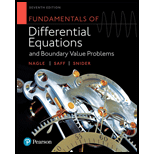
Concept explainers
In equation
Want to see the full answer?
Check out a sample textbook solution
Chapter 11 Solutions
Fundamentals Of Differential Equations And Boundary Value Problems, Books A La Carte Edition (7th Edition)
- MATLAB. Awnser written questions (*) in the comments. Null, Rank, and most functions outside of rref() and disp() are not allowed! Solutions must be given manually! Elementary form means to reduce to RREF manually, without rref(). Please see other attached image for explanationarrow_forwarda. Given D = (1 2,6 4 )decode the following message: 32, 24, 42, 28, 24, 40, 50, 60, 132, 96, 12, 24 where the item in brackets is a 2*2 Matrix and the rows are separated by commasarrow_forwardMATLAB. Awnser written questions (*) in the comments. Null, Rank, and most functions outside of rref() and disp() are not allowed! Solutions must be given manually!arrow_forward
- Matlab Do question #3 from Section 1.10 Exercises of the textbook (theproblem about Mac and Cheese). For each part, be sure to explicitly give the appropriate system ofequations (as a comment) before entering the appropriate matrices into MATLAB. Show all of yournecessary MATLAB computations.arrow_forwardPLEASE ANSWER ALL PARTSarrow_forwardPLEASE ANSWER BOTH PARTSarrow_forward
- (1) (16 points) Let f(x, y) = 2x + 3y + In(xy) (a) (6 points) Calculate the gradient field Vf(x, y) and determine all points (x, y) where ▼f(x, y) = (0, 0). (b) (4 points) Calculate the second derivative matrix D²f(x,y).arrow_forwardLet f(x, y) = 2x + 3y+ In(xy)arrow_forward(3) (16 points) Let D = [0, π/2] × [0, 7/6]. Define T: DCR2 R3 by → T(0, 4) = (2 sin cos 0, 2 sin sin 0, 2 cos x). Let S be the surface parametrized by T. (a) (8 points) Determine the normal, call it n(p), for the tangent plane TS at an arbitrary point p = T(0, 4). (b) (4 points) Show that n(p) parallel to the position vector T(0, 4) determined by p? Do the two vectors have the same direction or opposite direction? Explain. (c) (4 points) At which points p, if any, is TS parallel to the xy-plane?arrow_forward
 Trigonometry (MindTap Course List)TrigonometryISBN:9781337278461Author:Ron LarsonPublisher:Cengage LearningAlgebra & Trigonometry with Analytic GeometryAlgebraISBN:9781133382119Author:SwokowskiPublisher:Cengage
Trigonometry (MindTap Course List)TrigonometryISBN:9781337278461Author:Ron LarsonPublisher:Cengage LearningAlgebra & Trigonometry with Analytic GeometryAlgebraISBN:9781133382119Author:SwokowskiPublisher:Cengage

